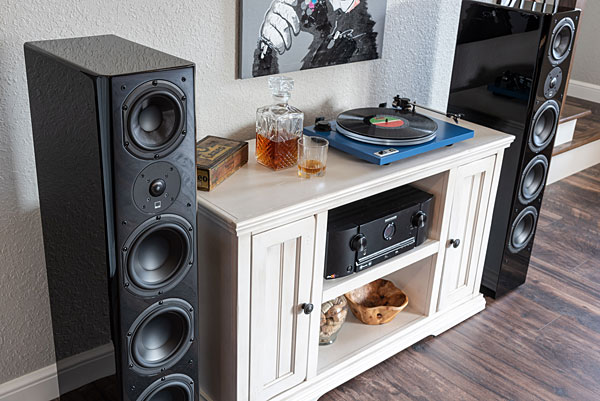SVS Prime Pinnacle Loudspeaker Page 2
Listening
I ended up with the towers positioned a good two feet-plus from baffle to front wall (the short wall) in my 16 x 22-foot studio, which put the bottom octaves solidly in balance. Thus situated, they proved, as I've come to expect from any SVS design, to be low-end prodigies. (When you make your bones on subwoofers, fans count on getting the down-low from low down.) An EDM track like "funkenspelunken," a file I harvested in 24-bit/96kHz format from some now-forgotten dubstep site, rolls out plenty of subtle-but-powerful sub-30 Hz content, both transient and sustained, and the SVS pair delivered this without substantial shortfall that I could detect. The sound was also free of any audible distress, doubling, or port-noise distractions up to quite high levels. I did not risk the SVS pair (or my amplifier) in attempting a true "club-level" playback but could nevertheless play even this very demanding track impressively loud. On a more music-critical front, an excellent version of Fanfare for the Common Man I found on Qobuz rolled forth with real weight, impact, and pants-leg-fluttering sub-40 Hz grunt from the big symphonic- bass drum thwacks. So, bass? Check.

The Prime Pinnacles also performed well with more everyday material. Overall tonal balance was extremely close to my long-term (and long, long- discontinued) Energy Veritas monitors, with just that touch more generously apportioned lower-midrange, and slightly less forward tip-top treble, that I expect from excellent current- fashion speakers, at least as compared with the relentlessly flat Energys. Consequently, a highly characteristic baritone voice like James Taylor's or Darius Ruckert's—an item always high on my tonal- balance checklist—sounded obviously right, without those traces of honk or chestiness that suggest critical-octaves colorations. Treble-revealing material such as high strings and harpsichord came across as relaxed yet complete-sounding.
I found the Prime Pinnacle's spatial performance both satisfying and interesting. Interesting because in my room the towers threw out a depth-of-image that extended about equally in front of and behind the speakers. (My Energys, like most direct- radiating speakers I encounter, develop their spatial mirage mostly behind-and-between the speakers.) The distinction was subtle but quite audible on simply-miked, live-space material like my high-resolution dub from a two-track master of a fine commercial performance of Weill's Threepenny Opera suite, captured in a well-known NYC church. (I could tell you how I came by it, but then I'd have to....) Here, the reverberant space forward of the ensemble was clearly sketched, even while the lateral placement of instruments remained tight and convincing.
Commercial studio productions were of course less dramatically depth-y, but still solidly imaged. And the SVS pair was happy to absorb all the clean power my 150 watts-per-channel power amp delivered. The result was, as mentioned, some impressive clean levels: On stuff like J.J. Cale's good- sounding (as usual—he was a trained engineer) posthumous album Stay Around (24/96 Qobuz stream), a track like the opening "Lights Down Low" could kick it out at pretty close to control room-playback levels, with cleanly etched transients and smoothly sustained pedal steel complementing a big, strong low end.

All these virtues came together on a track like "Can't Hide Love" from the Count Basie Orchestra, featuring the wonderful guest trombonist Wycliffe Jean (Concord Jazz, via 24/96 Qobuz stream). The amplified string bass and bass drum accents, perfectly coordinated, highlighted the controlled extension of the Prime Pinnacle towers, while the orchestra's trademarked, syrupy unisons spread elegantly across the middle in both width and depth. Meanwhile, Jean's vocalise trombone solo hung dramatically in space, with all its growls, wails, moans, and breathy details solidly rendered. The band's massed saxes and trumpets were suitably buzzy and brassy respectively, but all the while I could distinguish the faint but constant brassy tick of the hi-hat and the atmospheric shimmer of the ride cymbal, which floated over everything without once sounding buried, harshened, or amalgamated.
Conclusion
My above sonic descriptions of the Prime Pinnacle towers are all hallmarks of very good loudspeaker reproduction, so it should come as no surprise that I can recommend the company's new speakers, unreservedly, as a slam-dunk value. Have I heard tighter, more "audiophile-quick" bass, or airier tip-top treble? Sure—but not for less than two, three, or perhaps even six times the price. With the Prime Pinnacle, SVS not for the first time draws a line in the sand on the Value/ Performance Beach (found, perhaps, on the banks of the mighty Mahoning), and challenges all comers.





























































